Trip Highlights:
- Explore a floating market by sampan; meet a family at home & taste their local foods.
- Visiting local market and the house of French author Marguerite Duras.
- Explore the Tra Su flooded forest in a local boat. Search for 70 native bird species & rare turtles.
- Easy climb to visit the Mahayana Buddhist monks at Sam Mountain monastery; shop with chef.
- Tour the Royal Palace, Silver Pagoda & National Museum in Phnom Penh.
- Sip sundowners on deck as 3‐Nighters arrive; evening Khmer apsara dance performance.
- Head by skiff into Prek Toal Core Bird Reserve; transfer to Siem Reap. Depart.
Day 1 Siem Reap - Cambodia - Tonle Sap Lake
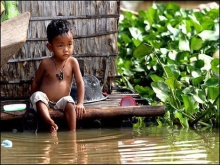
Arrival at Siem Reap Meeting Point. Your guides greet you and our porters collect your luggage for delivery to your Design Suite on the Upper or Lower Deck. Board our air-conditioned bus for the scenic 30 minute countryside ride to the dock on the Tonle Sap Lake.
Welcome to the laid back luxury of the Aqua Mekong. Settle into your elegantly appointed, river facing suite as the vessel begins to cruise and thus begins one of life’s most memorable and photogenic adventures. Ascend to the Observation Deck if you wish, to take in the view of the southern end of the Tonle Sap Lake, among the most fascinating eco-systems on earth. Often called the “heart of Cambodia” because millions of Cambodians depend on its waters.
Over the next seven nights, the Aqua Mekong sails from here along the one of the world’s great rivers towards remote natural and cultural destinations visited by only a few. First however, we begin with a Safety Drill followed by a briefing on the Observation Deck in the air-conditioned Indoor Lounge with the cruise director and hear from our expert guides about your Mekong adventures ahead.
We begin our cruise today along the Tonle Sap Lake, the largest freshwater lake in Southeast Asia. This great lake covers an area of around 250,000 hectares in the dry season. Listen carefully as our expert guides explain the unique hydrological phenomenon of the Tonle Sap: when the monsoon begins, the swollen waters of the Mekong River force the Tonle Sap River to reverse its flow northwards, feeding the lake and submerging the surrounding floodplains under up to ten meters of Mekong waters for several months every year.
Fortunately for us, the vast wetland area resulting from this cycle is home to an extraordinarily high biodiversity, both in terms of variety and abundance of species. Year round as well, the Tonle Sap is rich in bird life, including Brahminy kites, pied kingfishers and blue-tailed bee-eaters. The Lake is also one of the most productive captive fisheries in the world, providing more than 60% of the protein intake for the entire population of Cambodia.
We head first towards Kampong Khleang, passing through a landscape dappled with kapok trees, sugar palms and bamboo along the riverbanks. Peeking through this verdant curtain will be bright emerald green of rice paddy fields from June to November, or the yellowish dry earth from January to April.
Board Aqua Expeditions’ comfortable excursion skiffs for your first adventure. Life jackets, ponchos, and plenty of cold potable water are always available for you on board the skiffs.
A village built on wooden stilts over the water that is only accessible by land at certain times of the year, Kampong Khleang is home rice farmers and fishermen practicing their livelihoods as their ancestors did for generations, even though you may very well see them texting on their latest model mobile phones. We come here in part simply because the view en route in from the Tonle Sap, of hundreds of houses and other buildings rising above the water is, we think, stunning.
The many simple wooden paddleboats here attest to the importance of fishing in the inhabitants’ daily lives, as do the variety of fishing devices such as oblong traps called lop and V-shaped scoop nets. You may also see boats piled high with firewood heading to market, as 95% of Cambodians rely on this source of fuel for cooking. This reality makes commercial exploitation of Cambodian forests a growing concern for the future of the Tonle Sap’s delicate eco-system.
Meals: Dinner
Accommodation: Aqua Mekong Cruise
Day 2 Tonle Sap Lake - Kampong Khleang - Moat Kla
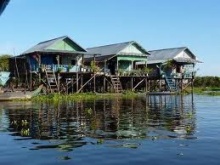
After a sumptuous breakfast, perhaps of Vietnamese coffee, fresh fruits, eggs to order and sweet banana sticky rice treats that the locals devour, we cruise onward from Kampong Khleang to the remote fishing village of Moat Kla. We climb back into the skiffs and head for shore where our expert guides act as translators, allowing you to pose questions to the people of Moat Kla about their lives.
You may be surprised to see that although most communities on the Tonle Sap are quite isolated, even Moat Kla has floating ‘convenience’ stores stocked with fishing tackle, cooking utensils, rice, beer, candy, fruits and vegetables. Along the water, there are also small merchants like fresh egg vendors, women selling bamboo stalks stuffed with sticky rice and even divers hired to search for lost objects.
Moat Kla is the last village in Siem Reap Province on the southeastern end of the lake and only accessible by water. The community is largely of Vietnamese descent, owing to its settlement long before the nuances of international borders.
Aqua Expeditions has made special arrangements for our guests to attend the blessing ceremony conducted at Moat Kla’s Buddhist temple, home to only four monks.
Meals: Breakfast/Lunch/Dinner
Accommodation: Aqua Mekong Cruise
Day 3 Chnok Tru - Kampong Tralach - Koh Chen - Tonle Sap River - Cambodia
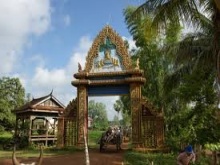
Continue exploring remote communities around the Tonle Sap River, an ecological hot spot designated as a UNESCO Biosphere Reserve in 1997. Today we head by skiff to Chnok Tru, as photogenic as it is remote and thus completely self-sufficient.
Here we “slide” into an ice factory, the importance of which will be obvious after even just one day in Southeast Asia. As local factory workers explain how they make and use the ice for fish preservation, our expert guides translate and get answers to your questions about this livelihood so different from ours. Also be on the lookout in this lake village for floating schools, riverside churches and pagoda, and even the karaoke bar and police station. Literally everything and everyone in Chnok Tru travels by small boat through the intricate network of canals crisscrossing this tiny town.
We return to the comforts of the Aqua Mekong and continue along the Tonle Sap River to Koh Chen. On the way, we pass Kampong Tralach, the site of Lovek, the capital of Cambodia after the Siamese King sacked Angkor in 1431. Though its glory days are long gone, this area was wealthy metropolis in its time and even attracted Europeans traders and missionaries through the 16th and 17th centuries.
By skiff we visit Koh Chen, or ‘Chinese Island’ in Khmer. The inhabitants of this riverside village are renowned throughout the region as silver and coppersmiths. They purchase the precious metals in Phnom Penh and return here to make ornamental items such as the cups, boxes and delicately engraved tropical fruits used in Buddhist ceremonies and marriage blessings. Each family member carries out an aspect of these ancient methods and the intricate, beautiful workmanship belies its humble origins. Purchase whatever catches your eye before we continue on to the pagoda. If the monks are in residence, we will experience an authentic Buddhist blessing ceremony.
Meals: Breakfast/Lunch/Dinner
Accommodation: Aqua Mekong Cruise
Day 4 Prek Bangkorng - Phnom Penh
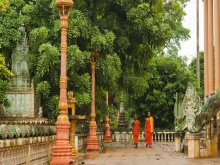
In the cooler morning time, we cruise further south towards the Cambodian capital of Phnom Penh. Around 90 minutes into today’s journey we pause to head by skiff towards the shore for a visit to the intricately carved Prek Bongkong Pagoda with its upturned naga and angels that appear to hold up the pitched Khmer roof. This area is known for a series of “silk islands” along the river. We visit one of these villages where the weavers allow us to wander among their looms, admiring their skills at this knotty art form. Witness the entire process here, learning how silk starts with the worms, see silk thread being looped and dyed, then admire and purchase, if you wish, the final shimmering Khmer silk accessories.
We returning by skiff to the Aqua Mekong, ready to continue another dozen kilometers to Phnom Penh.
Meals: Breakfast/Lunch/Dinner
Accommodation: Aqua Mekong Cruise
Day 5 Phnom Penh - Kaam Samnor - Cambodia
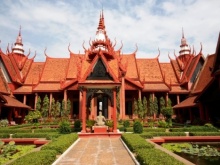
From the remote charms of the Tonle Sap River, we cruise into what may feel like another Cambodia altogether as we explore this country’s political and economic capital, Phnom Penh. Here, Art Deco buildings still stand in the shadows of ever-rising skyscrapers and vintage cyclos cruise alongside imported European sports cars. Buddhist temples, French colonial villas and the Royal Palace provide the photogenic backdrop to international business and a new generation of boutique hotels, chic shopping and cosmopolitan nightlife.
Today’s urban adventure by two wheel motorized tuk-tuks will take in this historic city’s most important sites including the 1866 Royal Palace that is still home to the reigning monarch and its Silver Pagoda, the royal compound’s most famous attraction, so called because in 1962 then Prince Sihanouk ordered the floor inlaid with 5,329 genuine silver tiles. Today the pavilion houses many jeweled statues and images, including the 17th century Emerald Buddha, made of Baccarat crystal, and a life size gold Maitreya Buddha adorned 9,584 diamonds, the largest of which weighs 25 carats.
Just next door, the National Museum of Cambodia houses the world’s largest collection of Khmer art, much of it removed from Angkor Wat to prevent looting. Here we can linger among the linga, representations of the Hindu deity Shiva, and thousands of other artifacts including an imposing 11th century bronze sculpture of a reclining Vishnu that is considered a monumental example of Khmer statuary.
For our guests who are interested to delve deeper into Cambodia’s recent past, we offer an optional excursion to the Tuol Sleng Museum of Genocide, with its extensive photographic evidence of the atrocities of the Khmer Rouge era and into the countryside to visit The Killing Fields.
Sip sundowners on the Observation Deck as our 3-Night guests arrive.
Join us in the evening for a performance by renowned Cambodian apsara dancers who continue an ancient tradition venerated on the intricately carved walls at Angkor Wat.
Meals: Breakfast/Dinner
Accommodation: Aqua Mekong Cruise
Day 6 Vinh Xuong - Mekong Border Crossing - Chau Doc - Bassac River
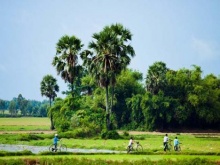
Say ‘Good morning, Vietnam’ as we cruise to the Vinh Xuong border and onward to Chau Doc village, which sits along the Hâu River, a tributary of the Mekong. After breakfast on board, perhaps a steamy pho soup in honor of our arrival, we head to the shore by skiff then by road for a change, about six kilometers, to the 230 meter (755 feet) high Sam Mountain, the highest point in the Mekong Delta, and home to dozens of pagodas that dot the mountainside, some even set in caves.
We make the easy climb to the mountaintop for the most captivating views of the surrounding countryside’s rice fields, and into Cambodia. We won’t be alone up here. As this is border territory, there is a military outpost on the summit. This legacy of the Khmer Rouge era confers a slightly anachronistic aura, which allows us some insights into the tensions of that horrific period, although these soldiers appear far more relaxed. If you ask, they will likely pose for your photos, assuming you have a few cigarettes handy as payment for their impromptu modeling duties.
Still at the top of Sam Mountain, Aqua Expeditions guests have the unique privilege to sit with the venerable Mahayana Buddhist monks at Long Son Tu Temple for a private audience. Enlightened, we head back down at the foot of Sam Mountain, stopping to visit the Temple of Lady Xu, one of the major religious sites of the Mekong Delta. According to a legend, in the early 1800s, villagers found a statue of a lady dating to the 6th century in the forest. In 1820 they completed this temple, originally built of bamboo and leaves, to honor her and in hopes that she would bring them better crops, thus improve their lives. Even today, the marble statue of Ba Chua Xu, meaning "country lady" is worshipped, with Vietnamese coming year round to ask for her protection and benediction.
Our chef heads into the local market here, along with any gourmet minded guests interested to explore an authentic Vietnamese wet market, its copious baskets of the day’s catch from the river, crisp vegetables and luscious tropical fruit.
Meals: Breakfast/Lunch/Dinner
Meals: Breakfast/Lunch/Dinner
Accommodation: Aqua Mekong Cruise
Day 7 Gieng Islet - Sa Dec - Cai Be
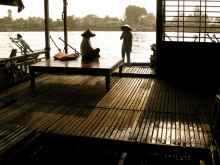
Though we are in the heart of Vietnam, French colonial architecture stands all around us today as we board the skiffs along the Tien River to a 40 square kilometer riverine island called Gieng Islet. Walk or cycle around this peaceful religious enclave on the Mekong Delta.
Together we visit Cu Lao Gieng Church, built in 1875 with materials imported from France. It is impossible not to admire its imposing bell tower that appears to pierce the sky high above its low-rise neighbors. At the Convent of the Providence Order and Catholic Church, interact with Sisters or Father to learn of the religious influences on the surrounding communities, which we may visit to admire the indigenous pagodas and wooden houses built in the early twentieth century in traditional Vietnamese design and shaded by bonsai trees, as was the local custom.
After lunch on board the Aqua Mekong, we continue our time travels back on shore with a tour on foot around the town of Sa Dec. We roam around the fresh produce and exotic spices on sale at the local market and make our way to the colonial house once occupied by French writer Marguerite Duras. The house, built in late 19th century, is interesting in itself as a harmonious combination of Western and traditional Vietnamese architectural styles.
Perhaps no one has done more to associate themselves with the Mekong Delta than Duras. Born in Gia-Dinh, as Saigon was formerly known, because her parents had responded to a campaign by the French government encouraging people to work in the colony, Duras’ early life here in Sac Dec was one of extreme hardship. Her father fell ill soon after the family arrived here and returned to France where he died shortly thereafter. Her mother remained in Indochina with Marguerite and her two siblings, eking out a meager living as a schoolteacher. It was here in Sa Dec that the teenaged Duras and Huynh Thuy Le, a rich Sa Dec merchant began their affair that Duras wrote about in her most famous work The Lover.
Meals: Breakfast/Lunch/Dinner
Accommodation: Aqua Mekong Cruise
Day 8 Cai Be - My Tho - Saigon
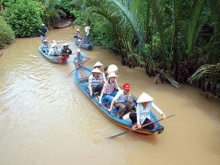
Here in the Mekong Delta, people rely on flat-bottom wooden boats called sampan to get around and transport goods to market. On our last morning together, we climb aboard to paddle through Cai Be floating market, where more than 400 sampans gather every day, starting in earnest from 5 a.m.. Each boat has one bamboo stick on the front to display that vendor’s product, be it Vietnamese fish sauce, rice paper for dumplings, or colorful sweet confectionery. We continue our exploration of this area on foot or by bicycle for more up close glimpses of daily life of Mekong Delta dwellers, and even take up the invitation of local friends of Aqua Expeditions to dine in their traditional home.
We return to the Aqua Mekong and continue cruising towards My Tho. Here, we pack up and bid farewell to the crew to take the van transfer to Saigon, stopping en route to visit the Dong Tam crocodile and snake farm about nine kilometers west of My Tho.
Officially known as the Medicinal Plants Cultivation and Research Centre of Military Zone 9, the largest center for snake rearing and snakebite treatment in the Cuu Long River Delta was established in 1979 in an area full of mines and barbed wire left by the United States Army. Since then, the 12 hectare farm has been engaged in scientific research that involves rearing and conserving precious species of snakes, medicinal plants and animals, as well as producing traditional medicines and providing first aids and treatment for people who are bitten by poisonous snakes. Learn about the various types of snakes slithering around the Mekong Delta, watch the production of cobra venom for medical purposes and from a safe distance, admire the center’s efforts to preserve endangered King cobras. We continue onward by air conditioned bus through the Vietnamese countryside and into the bustling metropolis of Saigon.
Meals: Breakfast
Accommodation: NA


